Do you currently have clownfish breeding in your tank? Or perhaps you want to learn how to breed clownfish and raise clownfish eggs to help your baby clownfish survive and thrive. Either way, I hope you’ll enjoy learning about clownfish breeding, egg-laying, and some of the lessons I learned from breeding them.
Did Your Clownfish Lay Eggs?
Raising baby clownfish from the eggs laid in my reef aquarium is one of the coolest things I’ve experienced in this hobby. If your clownfish pair laid eggs in your tank, congratulations! I’m glad you get to share in this experience.
Of all the saltwater fish species kept in aquariums, clownfish are probably the most likely candidates to breed. But raising baby clownfish from eggs to adults requires patience, persistence, a bit of luck, and some extra equipment. (Woo-hoo! I know you were looking for an excuse to get some new gear)
When my clownfish started breeding, I was an uber-nerd about it. (Okay, I’m still an uber-nerd) I wanted to document what was happening. So I wrote down my observations, and I include them here for your consideration.
Clownfish breeding isn’t the shortest topic in the world. And while I hope you’ll stick with me through the entire process, I recognize that things might get lengthy with this post. So I’ve provided a handy Table of Contents for anyone that wants to skip ahead to the section you want to focus on. Otherwise, we’ll dive right into everything you ever wanted to know!
Table of contents
- Clownfish Eggs: Quick Facts
- Feeding Clownfish to Promote Breeding and Laying Eggs
- Clownfish Lifespan
- How Many Eggs Does a Clownfish Lay?
- The Clownfish Breeding Journal
- What to Feed Clownfish Larvae
- How to Raise Baby Clownfish
- How Often Do Clownfish Spawn?
- For More Information
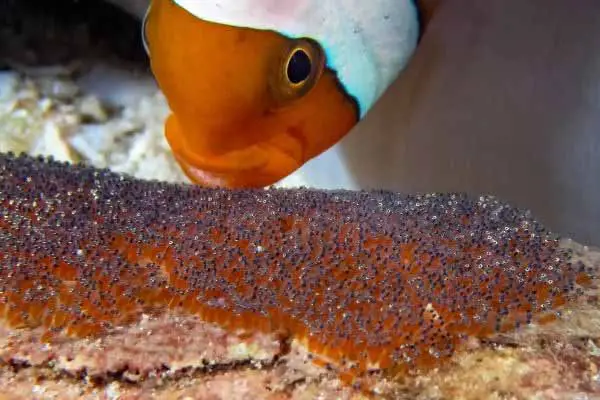
Clownfish Eggs: Quick Facts
How Long Does it Take Clownfish Eggs to Hatch?
When spawning regularly, clownfish spawn about every 10-14 days. The clownfish eggs then hatch between 8 and 10 days later. The larvae hatch on back-to-back evenings – something which will drive you nuts if you try to collect them from a breeding tank.
Will Clownfish Eggs Survive?
Yes! If properly fertilized and cared for by the male, clownfish eggs will survive until they hatch – around 8 days after fertilization. After that, you’ll see tiny clownfish larvae about three millimeters in length. The newly hatched larvae, however, require special feeding and care for continued survival.
How Many Eggs Do Clownfish Lay?
A female clownfish will lay between 100- 1,500 eggs (approximately) every two weeks.
Where Do Clownfish Lay Their Eggs?
Clownfish clean a small patch of rock near the area where they spend most of their time and lay their eggs on that rock. In aquariums, aquarists who breed clownfish sometimes provide clay pots or tiles as easy-to-remove and handy substitutes for more natural rocks.
Feeding Clownfish to Promote Breeding and Laying Eggs
If you want to breed any of the clownfish types, you need a happy, well-fed pair. So what have I been feeding my clownfish? I regularly feed them at least twice a day (during the week) and 3 times a day on the weekends. I like to feed them live blackworms and brine shrimp (when in stock at my local fish store), frozen Mysis shrimp, freeze-dried Mysis shrimp, Ocean Nutrition pellets, and spirulina-20 flakes.
Not all at once (of course). I mix it up. Since the black worms are fresh, live food, I binge-feed those when I have them. (They get nasty in the fridge after a couple of days, so I feed those as much as they will eat them) Other than that, I rotate through the other foods based on how much time I want to spend feeding and what they’ve been eating. I try not to let it go for too many days with the same food on the menu.

The important thing, in my mind, is feeding multiple times a day with plenty of calories. You want your clownfish to grow quickly, fatten up, and have enough calories to sustain them through breeding. Then they won’t be tempted to eat the eggs.
So try to feed a variety of high-quality, high-calorie foods 2-4 times a day, based on your schedule.
Clownfish Lifespan
How long do clownfish live? According to certain sources, like National Geographic, the average lifespan of a clownfish in the wild is about 6-10 years. While I haven’t seen a scientific article examining clownfish lifespans inside home saltwater aquariums, I suspect it isn’t far from the average. I’ve certainly kept my fair share of clownfish who have, unfortunately, lived shorter than the average.
I’ve read posts online heralding individuals or pairs that have lived well into their teens (I’m pretty sure Gary Parr, from Reefs, is one of the lucky owners of a teenager). So, the thing to keep in mind with average lifespans and applying them to your reef aquarium is that if we do our job well, there is certainly the chance to outlive the average range.
At the moment, the oldest clownfish in my system is a black ocellaris that is about 6-7 years old (depending on how old she was before I got her). Over the years, I’ve had three who lived to about that range.
How Old Do Clownfish Have to be to Breed and Lay Eggs?
Clownfish have the potential to reach sexual maturity around 1.5-2 years of age. I say, “have the potential,” because a few environmental factors will influence this.
All clownfish are hermaphrodites, which means they have male and female organs. They start out their lives as immature males. If they remain together as a group, all the fish in the group – except for two – will remain immature males. One fish will become the mature, breeding male, and the other will change gender from male to female and become the breeding female.
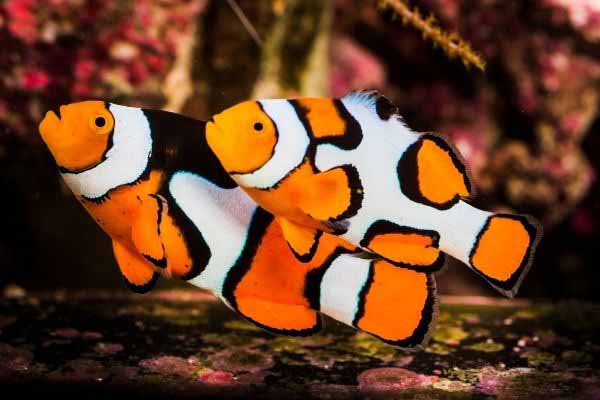
If she dies, the breeding male changes gender from male to female. Then one of the immature males gets ‘promoted’ to become the mature, breeding male. So, that’s why I said they have the potential to become mature around 1.5-2 years old.
But, as you can see from the example above, they could be much older and still immature, depending on the group’s dynamics. The good news here, however, is that hermaphrodism makes it relatively easy to establish a clownfish breeding pair.
How Many Eggs Will a Clownfish Lay?
A clownfish will lay anywhere between 100 and 1,500 eggs in a single clutch or spawning event. An average pair produces somewhere around ~400-500 (Wilkerson 2001). Please note, this is an affiliate link to Amazon. The book is not currently in print, but if you wish to view it on Amazon (or see if you can score it at a local fish store), be my guest. Please note that if you buy anything from Amazon due to clicking this link, I will receive a small commission on your purchase. (No pressure at all)
The number of eggs a clownfish lays at any given time varies based on:
- Species
- Relative age and health of the pair
- Nutrition/feeding
Larger clownfish types, like the maroon clownfish, may lay 1,000+ eggs at a time. Smaller species, like the common clownfish or even a designer type like the Snowflake clownfish, may only lay a couple hundred.
Still, that’s a lot of clownfish babies, if you can raise them all!
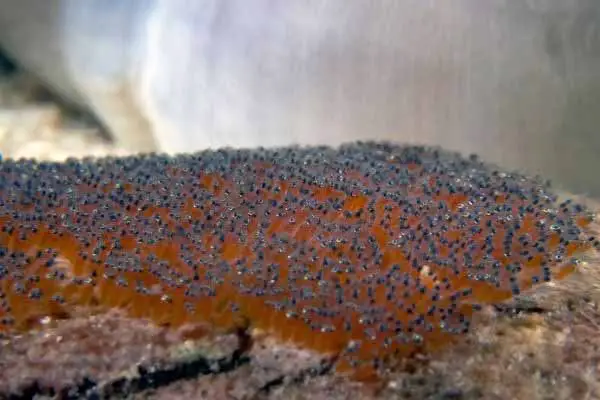
What is the best clownfish salinity?
The best clownfish salinity (the amount of salt in the saltwater) is 35 parts per trillion (ppt) at 79 degrees Fahrenheit, which could also be measured as a 1.025 specific gravity, to match the natural salinity of their home reef ecosystems.
Clownfish Breeding Journal
The Ocellaris clownfish, Amphiprion ocellaris, is probably the most popular saltwater aquarium fish in the world. Clownfish breeding and raising the larvae from eggs laid on the glass inside my saltwater aquarium is one of the coolest things I’ve yet experienced with this hobby. Some people think clownfish need an anemone, like the bubble tip anemone, to spawn. But I’ve had clownfish spawn multiple times without an anemone, and I’ve had them take up residence corals as surrogate anemones, including a Toadstool coral, Happ
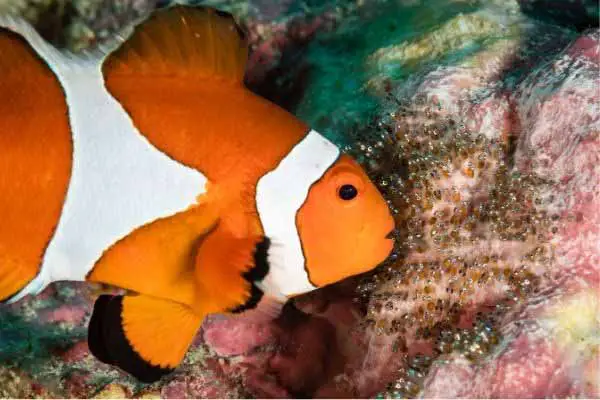
When I observed clownfish breeding for the first time, I posted observations periodically. While the information got captured in raw fashion as it happened, the posts need tidying up and organizing. Two years passed since those first days, and I’ve learned a lot in that time.
This post is the culmination of the information spread out across those earlier blog posts and my clownfish breeding journal. To use the word “comprehensive” (Wordy?) is an understatement. Big-time disclaimer here: If you don’t want to slog through a long post -bookmark it and come back later.
My two hopes for this post are:
- You learn something about clownfish breeding and the eggs’ development
- That if you can help add to the content here, you leave a post and help everyone out
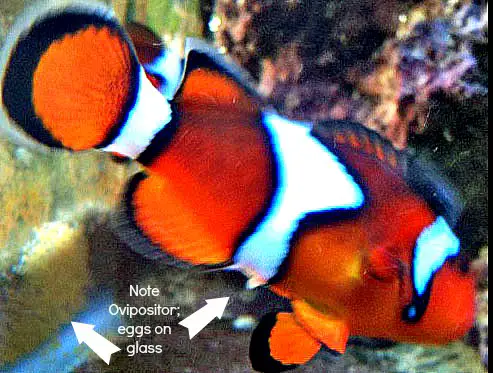
Above, you’ll note a picture of a female clownfish after laying her eggs on the aquarium glass. The peach-colored eggs adhere to aquarium glass below her tail. I know she’s a bit blurry in the picture, but what I thought was cool about this photo is the clear view of the ovipositor, the tube through clownfish eggs pass through as she lays them.
Clownfish Breeding Overview
The first time I observed clownfish breeding in my tank, the pair spawned in the front-right corner. One day, while watching, I found the clownfish eggs on the aquarium glass. Of course, clownfish won’t always spawn on aquarium glass. Instead, they might choose a rock, tile, clay pot, or aquarium decoration.
My attempts at coaxing them to use a substrate of my choice failed many times. I put tiles, a sheet of glass, and clay flower pots in their breeding corner, trying to coax them into using something I could remove from the tank on hatching day. But they moved on and found other patches of glass to lay their eggs on.
I did have some clownfish breeding success in a separate tank with a different clownfish pair by getting that pair to lay their eggs in a clay flower pot. You should try to encourage your clownfish to spawn on a removable substrate. It’s much easier to hatch the eggs in a grow-out tub than to catch the larvae after hatching and then move them.
Day 2: Keeping the Clownfish Eggs Clean
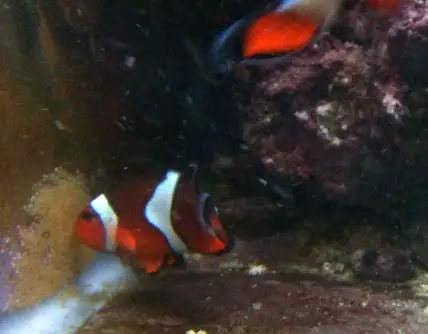 By the second day, the male started tending the eggs. And this is where he spent most of his time over the entire 8-day period. The pecking activity appeared somewhat excited or nervous at times, especially when I approached the aquarium too closely. At first, it looked like he was trying to eat the eggs (he’s not). I knew this was normal behavior; he was keeping the eggs clean. Though I wondered if he acquired a taste for caviar each time.
By the second day, the male started tending the eggs. And this is where he spent most of his time over the entire 8-day period. The pecking activity appeared somewhat excited or nervous at times, especially when I approached the aquarium too closely. At first, it looked like he was trying to eat the eggs (he’s not). I knew this was normal behavior; he was keeping the eggs clean. Though I wondered if he acquired a taste for caviar each time.
The picture above shows the eggs on Day 2. Note the color of the clownfish eggs: still a very similar pale peach/orange color to the day they were laid.
When he wasn’t biting at the eggs, he hovered in front of them, beating his pectoral fins or swimming up and away with a swoop of his tail. Then, he’d return again a moment later. After the eggs were laid, he spent most of his time pecking at the eggs with his mouth or fanning them with his pectoral fins.
The female, by comparison, was less attached to the nest. She circled the spawning area but at a greater distance. Occasionally, she’d swim closer to interact with the male. But, I was surprised to note that despite his apparent attachment to the nest (dare I say obsession? Let’s face it: If those eggs had a Facebook page, he’d be creeping all over it. But I digress), the male would abandon the eggs at feeding time. Once he ate his fill, he returned to the nest.
Day 3: Clownfish Eggs Turn Silver in Color
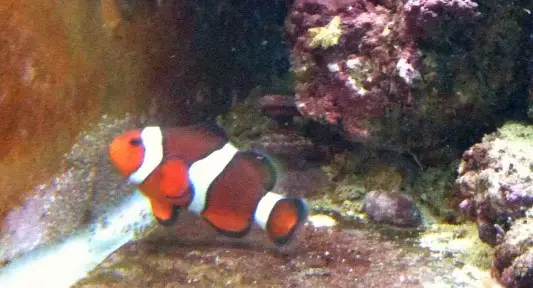 By Day 3, the clownfish eggs changed color from the fleshy peach/orange color to a drab gray. Then, unfortunately, the number of eggs dwindled. Anecdotally, I’ve observed this in every clownfish breeding attempt over the past 2 years. The amount of thinning seems to vary from egg clutch to egg clutch.
By Day 3, the clownfish eggs changed color from the fleshy peach/orange color to a drab gray. Then, unfortunately, the number of eggs dwindled. Anecdotally, I’ve observed this in every clownfish breeding attempt over the past 2 years. The amount of thinning seems to vary from egg clutch to egg clutch.
Day 4: Clownfish Eggs Develop Sheen
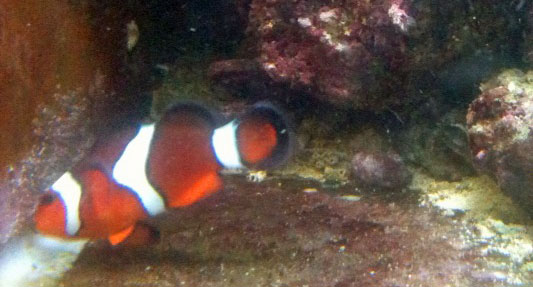 On Day 4, the number of clownfish eggs shrank. I found the male constantly guarding and cleaning the eggs. The clownfish eggs continued to change in color, going from a dull gray to a shiny/metallic gray on day 4. The larvae inside the egg continued to grow and develop.
On Day 4, the number of clownfish eggs shrank. I found the male constantly guarding and cleaning the eggs. The clownfish eggs continued to change in color, going from a dull gray to a shiny/metallic gray on day 4. The larvae inside the egg continued to grow and develop.
Day 5: Clownfish Eggs Develop Eye Reflections
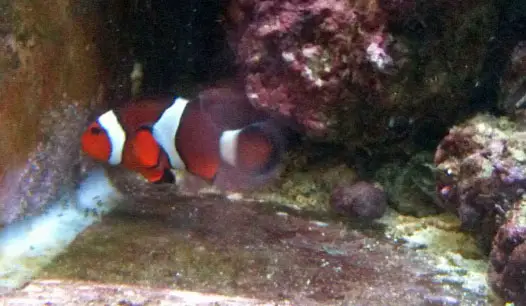
The most interesting change in the clownfish eggs began on Day 5. About 5% of the clownfish eggs (approximately one in 20) developed tiny eyes that reflected the light as the eggs swayed in the water current. Nothing is cooler than seeing tiny eyes through the egg casing. So, that was a reality check that things were progressing much better than before. But, it also let me know I needed to get prepared. So, on Day 5, I set up my equipment for growing out the larval fish:
- A black round tub
- Heater
- Air pump
- Airline tubing with a valve for regulating airflow
- Rotifer culture
Days 6-7: Clownfish Eggs Grow Larger
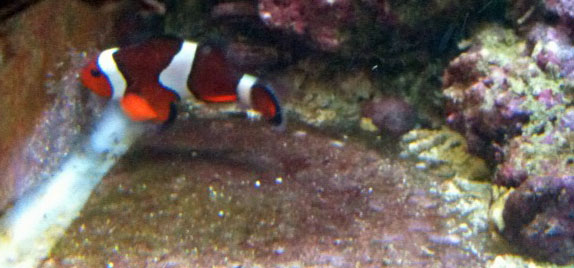 By Day 6, about three out of every ten eggs had shiny, reflective eyes. By Day 7, the majority had reflective eyes. The eggs seemed bigger (or at least distinct) and visibly swayed back and forth in the current as well as in response to the male fanning them with his pectoral fins.
By Day 6, about three out of every ten eggs had shiny, reflective eyes. By Day 7, the majority had reflective eyes. The eggs seemed bigger (or at least distinct) and visibly swayed back and forth in the current as well as in response to the male fanning them with his pectoral fins.
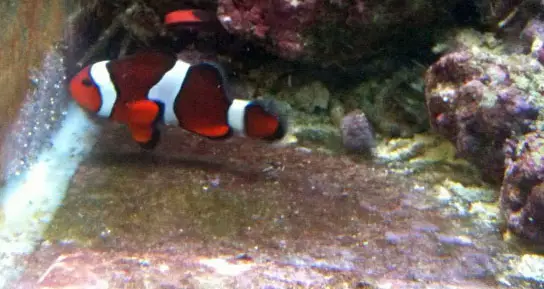
Day 8: Clownfish Eggs Prepare to Hatch

Day 8, after the initial clownfish breeding and egg fertilization, the clownfish eggs were set to hatch. They were large, reflective silver in color, and swayed in the breeze. Eyes were clearly visible in every egg.
I could just imagine them ready to burst. And that night, they did. Disclaimer: Now, after seeing plenty of clownfish breeding attempts from two separate pairs of Amphiprion ocellaris, the day of hatching can vary between 8 and 10 days. The best advice I can give: be prepared early with your grow-out tub and food cultures, and check on them starting on day 8.
Clownfish Breeding Journal: Egg Hatching
After eight days of waiting, nail-biting, and pacing like an expectant parent, the clownfish eggs finally hatched. But not the traditional way. Then, in the blink of an eye, I panicked and made a bone-headed move.
I intended to use a flashlight to attract the larvae and scoop them out with a bowl (the way Martin Moe suggested in his article on breeding the neon goby). My backup plan was to set up a DIY larval snagger I had made (if they hatched too late into the evening). But I got really nervous because the other fish in my tank seemed to hover around the nest in anticipation. (I wonder if I was projecting intuition onto the fish or if they knew something was up) Either way, what I saw was enough to spook me into changing my plan.
I read a few forum posts about aquarists siphoning clownfish eggs out of the tank before they hatched to eliminate the risk of predation. Unfortunately, I’m pretty sure I caused more damage than good by attempting this approach. In the end, only FIVE larvae survived the extraction. It hurts me to even relive this and type those words.

Later on, I DID attempt to use a DIY Larval Snagger – with mixed results. The Snagger worked okay. The issue was the other fish in the tank ate more than their share of larvae while they were being snagged. So I tweaked my Larval Snagger and wrote a post about how to make your own DIY Larval Snagger.
For what it’s worth, I’ve had better success using the Larval Snagger in tanks dedicated to a breeding pair than in a community display tank – where hungry mouths perform their own version of larval snagging.
Problems, Problems, and More Problems
It would be disingenuous to suggest that my clownfish breeding experiences were all easy from that point on. Success remained difficult. Plenty of clownfish larvae died. The challenges with spawning and capturing larvae were only the beginning. And unlike in my reef tank, I didn’t have the benefit of clean up crews or bristle worms to help me keep things in check.
Rotifer and phytoplankton cultures crashed, starving some of the poor larvae. (I will get into the food cultures – copepods, rotifers, and phytoplankton – in the next section, but for now, know that you will have problems. Expect crashes. The best thing you can do to hedge against crashes is have multiple independent cultures going. Save small samples of your cultures, replacing them as you progress every couple of days. Because you never know when you will need it to feed some hungry larvae or restart a crashed culture)
A cheap heater malfunctioned and cooked a batch of baby clownfish larvae.
Countless poor larvae were damaged by clumsy (unintentionally clumsy) capture and transfer.
Only after making nearly every bone-headed move possible did I eventually have some success.
The good news is that your clownfish will hopefully breed about every two weeks, providing you with plenty of opportunities to get things right. The larvae that survive will be okay with the special kind of rearing only you can provide.
(Feel free to post a comment here with any challenges you may be facing. You’re not alone in this. Someone out there has likely had the same issue.)
How to Feed Clownfish Larvae
 When the larvae hatch, baby clownfish look like tiny shards of glass with big eyes. They are mostly colorless, and the light from a flashlight bounces off the eyes with a metallic sheen. The MOFIB thread on breeding clownfish states that the larvae are 3mm at hatching. I didn’t measure them but can agree that it seems about right. (It’s really pretty small when you see it in action)
When the larvae hatch, baby clownfish look like tiny shards of glass with big eyes. They are mostly colorless, and the light from a flashlight bounces off the eyes with a metallic sheen. The MOFIB thread on breeding clownfish states that the larvae are 3mm at hatching. I didn’t measure them but can agree that it seems about right. (It’s really pretty small when you see it in action)
The really amazing part is how small the mouth of something is when the total length of the entire larva is only 3mm long. Look how small they are relative to the parents in this video:
Because they are so small, if you want to be successful with clownfish breeding (or breeding any other saltwater fish, for that matter), you will need to become proficient in growing out (culturing) live copepods, rotifers, and phytoplankton.
The basic process of caring for the nutritional needs of clownfish is to create a culture of phytoplankton, a culture of rotifers, and a culture of copepods (if you can find them). In essence, you need to create a miniature food web. First, you grow the phytoplankton to feed the rotifers and/or copepods. Then, you grow the rotifers and copepods to feed the clownfish larvae.
I fed the clownfish rotifers until Day 10 when I started introducing baby brine shrimp (just hatched). Rotifers are the right size for larval clowns to eat, but they do not have much nutritional value. What little value they have comes from the phytoplankton in their gut.
Brine shrimp, by comparison, is a dense food. So you need to feed the clownfish much less. When first introducing brine shrimp, it is also important to add tiny quantities of baby brine shrimp – less than 12 hours old. According to Wilkerson’s book, brine shrimp molt and grow after 12 hours and can reach a size that will actually choke your clownfish.
After several days of feeding both rotifers and baby brine shrimp, I stopped feeding rotifers altogether. Similarly, once the fish were eating only baby brine shrimp, I started feeding crushed flakes and crushed freeze-dried foods. By around Day 20, I’m pretty sure all of the fish were eating dry food and live brine shrimp. I wrote a brief post on this topic and connected it with a YouTube video of the young clownfish eating live brine shrimp.
 How to Raise Baby Clownfish
How to Raise Baby Clownfish
My first success in raising baby clownfish larvae happened several weeks later. The fish in my display tank had become quite adept at snagging the larvae before I could and made meals of them. The success came on a night I wasn’t expecting. I must have missed the first day the eggs were laid because the eggs all hatched one night earlier than I had planned for.
My Banggai cardinalfish was greedily gulping up larvae. I managed to rescue ten larvae that night. I had rescued baby clownfish larvae before, but there was no disaster this time (unlike the previous times). No phytoplankton or rotifer crashes, no malfunctioning heaters, no dim-witted decisions.
I wrote a blog post and posted an unimpressive nine-second video of the clownfish larvae three days after hatching, swimming in their grow-out bucket. They didn’t look like more than tiny slivers swimming through some green water, but they represented progress.
Along with the good fortune of avoiding disasters, I also made a few changes to my setup. Previously, I was using a 20-gallon black round tub. I bought it at a hardware store (the kind with the rope handles you might purchase for yard work or to hold sodas for a cookout).
That proved to be too large of a volume to be practical. It’s important to keep the density of rotifers high in the beginning. The clownfish larvae shouldn’t have to swim very far to find a tasty treat. And keeping the 20-gallon tub full of rotifers was a challenge. So instead, I found a jet-black 5-gallon bucket. Scaling back my operation really seemed to help.
Growth was slow for this batch. At the end of that ordeal, I had one tiny juvenile baby clownfish survivor. But hey, it was a start.
The clownfish kept breeding, and I had other opportunities to improve my skills. So keep at it, learn from the mistakes you make along the way, and eventually, you will find yourself staring at a black round tub full of clownfish babies.
For me, it felt like a painfully long time to get to the first success. But after I broke through, I seemed to have more and more success. In the video below, you can see the different growth rates of juvenile clownfish in one particular batch.
Some of the baby clownfish are still dark with only one stripe. Others have two stripes. And a few have gone almost completely orange in color and have grown into their third stripe. Again, this is related to how quickly they grow. I noticed that the slower-growing clownfish also tended to be the slowest to adjust to the food changes or were least adept at eating the new foods.
How Often Do Clownfish Spawn?
With two pairs of clownfish breeding on overlapping schedules, I was able to get an overall feel for the general timing of the spawning attempts and how long it takes for the eggs to hatch. Both pairs, in separate systems, turned out to be regular with their spawns. Over the years, the clownfish have gone through periods of extreme regularity and other periods where no breeding activity seems to occur at all.
When spawning regularly, the clownfish spawned about every 10-14 days. The clownfish eggs hatched between 8 and 10 days after being laid. The larvae often hatched on back-to-back evenings, which will drive you nuts if you are trying to collect them from the breeding tank.
It is much easier to take care of the fish and rescue the baby clownfish if you set up a dedicated breeding tank. The clownfish seem less anxious, and they generally leave the newly hatched larvae alone if you need to snag the larvae out of the breeding tank after hatching.
Learn More About a Particular Clownfish Species
A great way to keep learning about clownfish, have a chance to establish a pair, and eventually get your own clownfish eggs and babies is to check out these great articles about a few of the most popular individual clownfish species:

For More Information
If you liked this article, you might also like the articles I wrote about my experiences with breeding the Banggai cardinalfish and breeding the neon goby.
The Go-To place for you to learn more about breeding clownfish and discuss the process with like-minded aquarists who share your passion for breeding clownfish is the Marine Ornamental Fish & Invertebrate Breeders Forum.
If you are interested in purchasing a book on the subject, the best book is the one I’ve previously cited, written by Joyce Wilkerson: Clownfishes: A Guide to Their Captive Care, Breeding & Natural History. The problem is this book isn’t in circulation anymore. But if you see it around in a local fish store or from someone getting out of the hobby, snatch it up. It is an easy read, has great pictures, and is a blast.
The best overall book about breeding saltwater fish is Matthew L. Wittenrich’s book, The Complete Illustrated Breeder’s Guide to Marine Aquarium Fishes. Disclaimer: This is another affiliate link through Amazon. I’ll get a small commission if you buy it. (I like the Amazon links because you can read reviews and even browse the book online) If you decide it sounds interesting, get your copy from your fish store or bookstore of choice. Know that if you buy anything via that link, Amazon will know you came from here, and the blog gets a small credit. For what it’s worth, Wittenrich’s book is my favorite aquarium book, period.

The only reason I put it second to Wilkerson’s book on the list is that the Breeder’s Guide covers much more than just clownfish breeding. The book covers everything you need to know to get your hands wet and try clownfish breeding. If you’re a nerd like me, you’ll end up sleeping with this book under your pillow.
A third option is Frank H. Hoff’s book, Conditioning, Spawning, and Rearing of Fish, with an Emphasis on Marine Clownfish. It’s not really a fair assessment because I read the other two books first (and was biased by them), but I found Hoff’s book less of a page-turner. I read Wilkerson and Wittenrich’s books cover-to-cover multiple times, whereas I found myself skimming through Hoff’s book.
Also trivial, but the edition I have of Hoff’s book is not bound as nicely as the other books. The pages are filled with graphs and tables, so it reads more like a research paper than a mass-market book. If that’s your thing, go for it. This book is also harder to get than some other books. (Also an affiliate link)
Learn More About Breeding Clownfish
Do You Have Clownfish Breeding and Laying Eggs in Your Tank?
If you have ever had clownfish eggs in your tank, please leave a comment and let us know. Link to a picture if you have one!
Written by Albert B. Ulrich III.
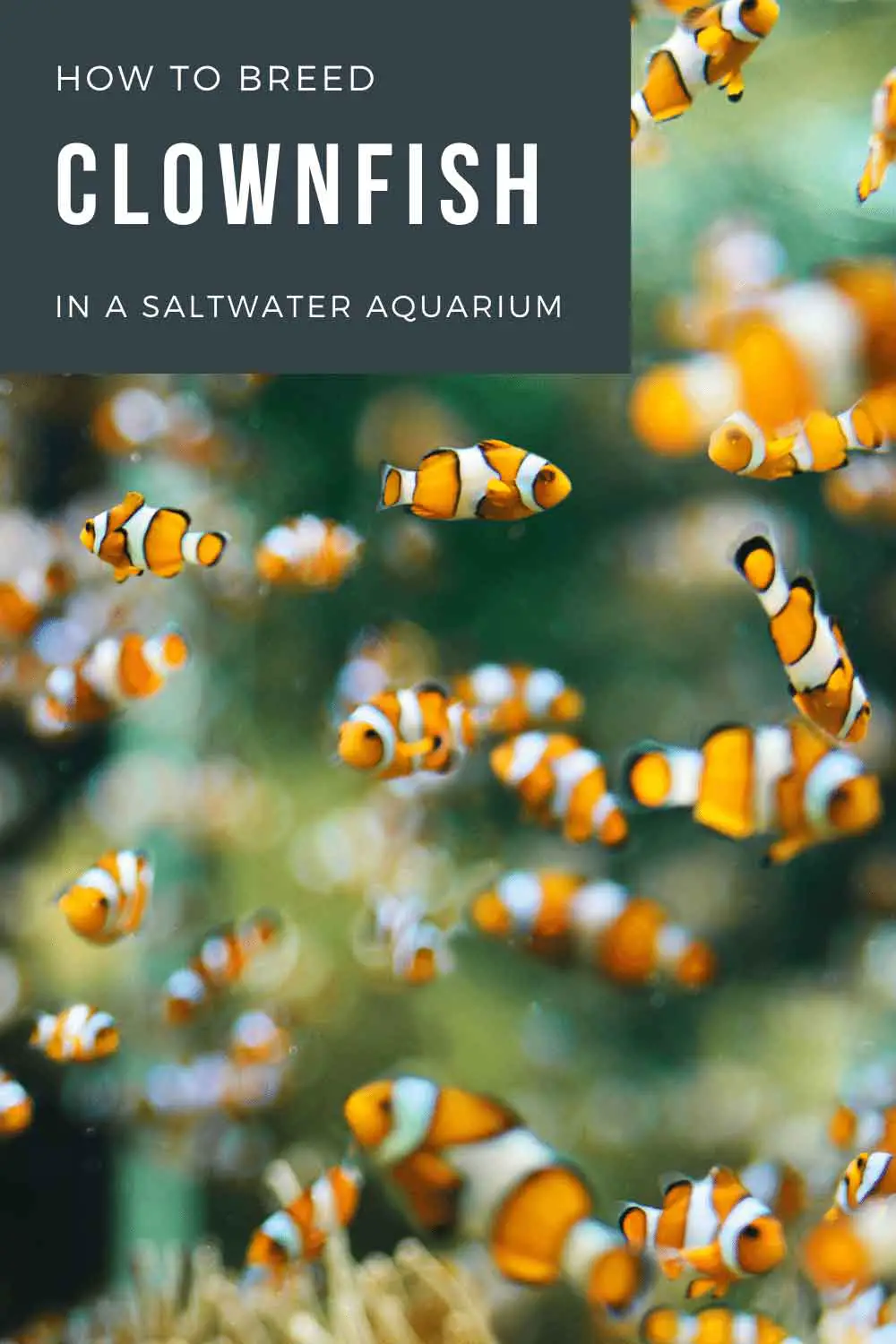

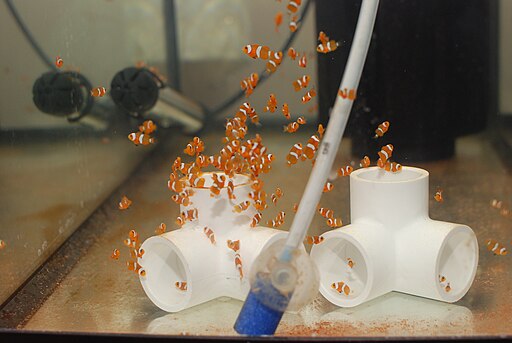
Leave a Reply